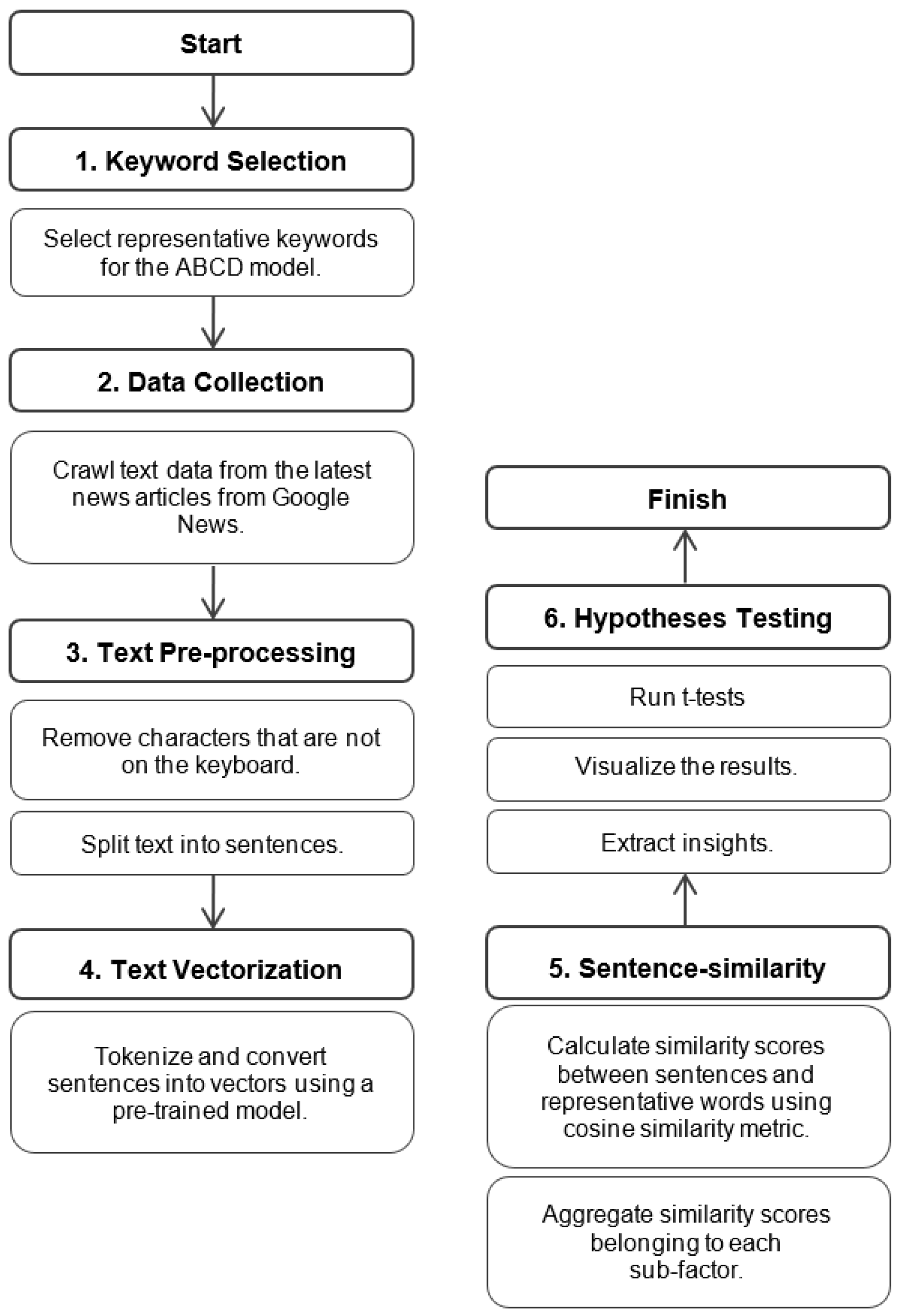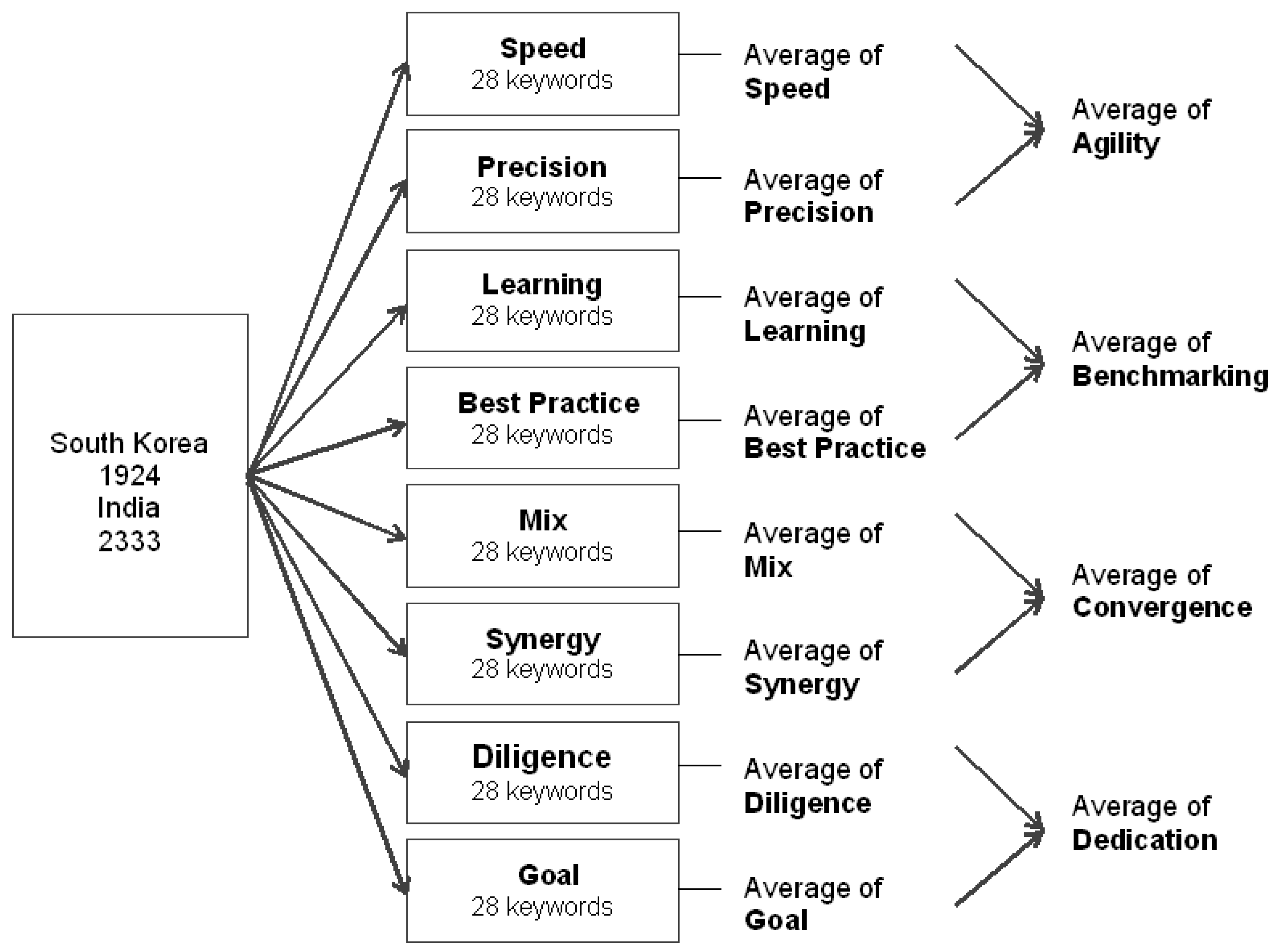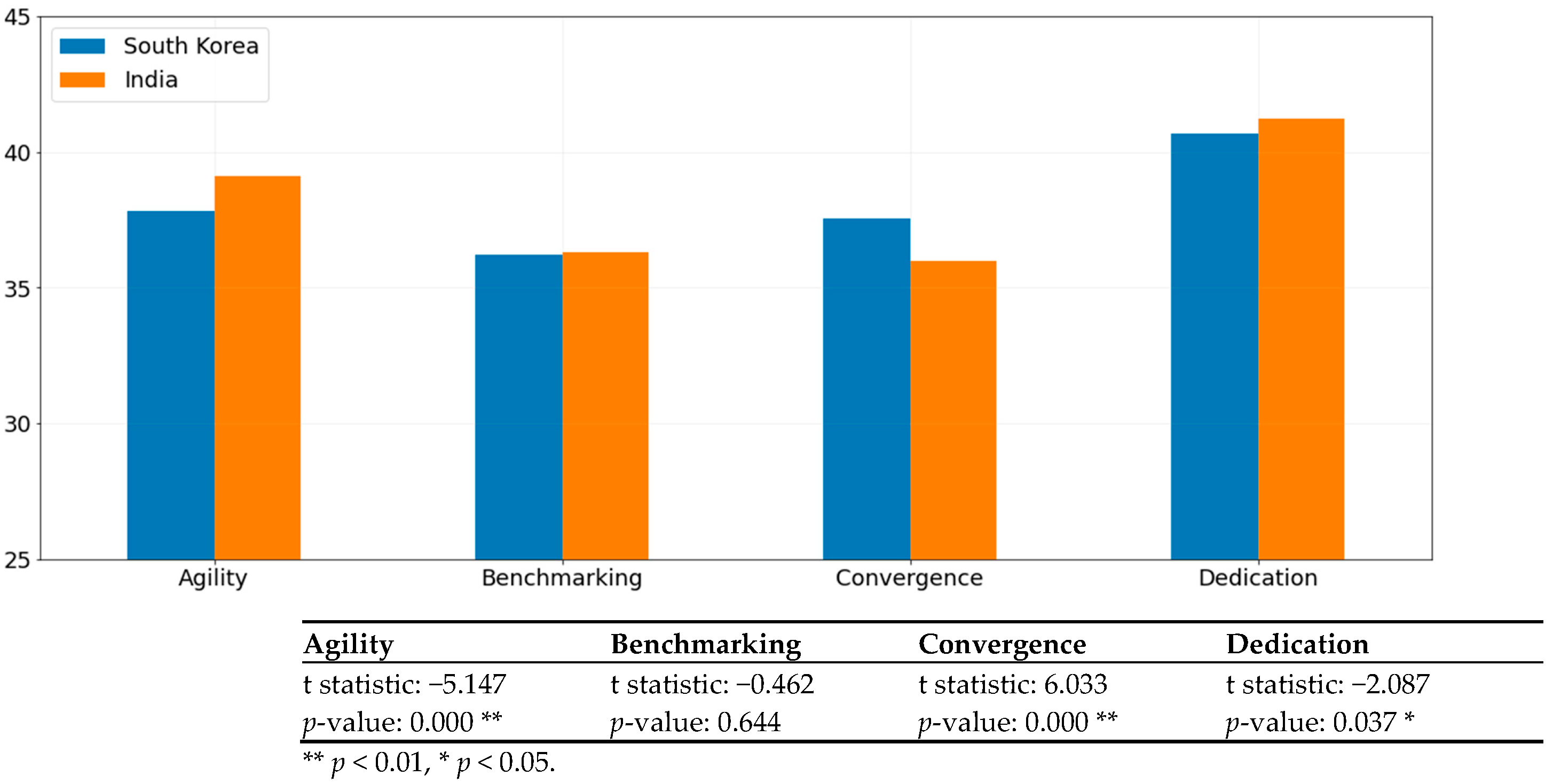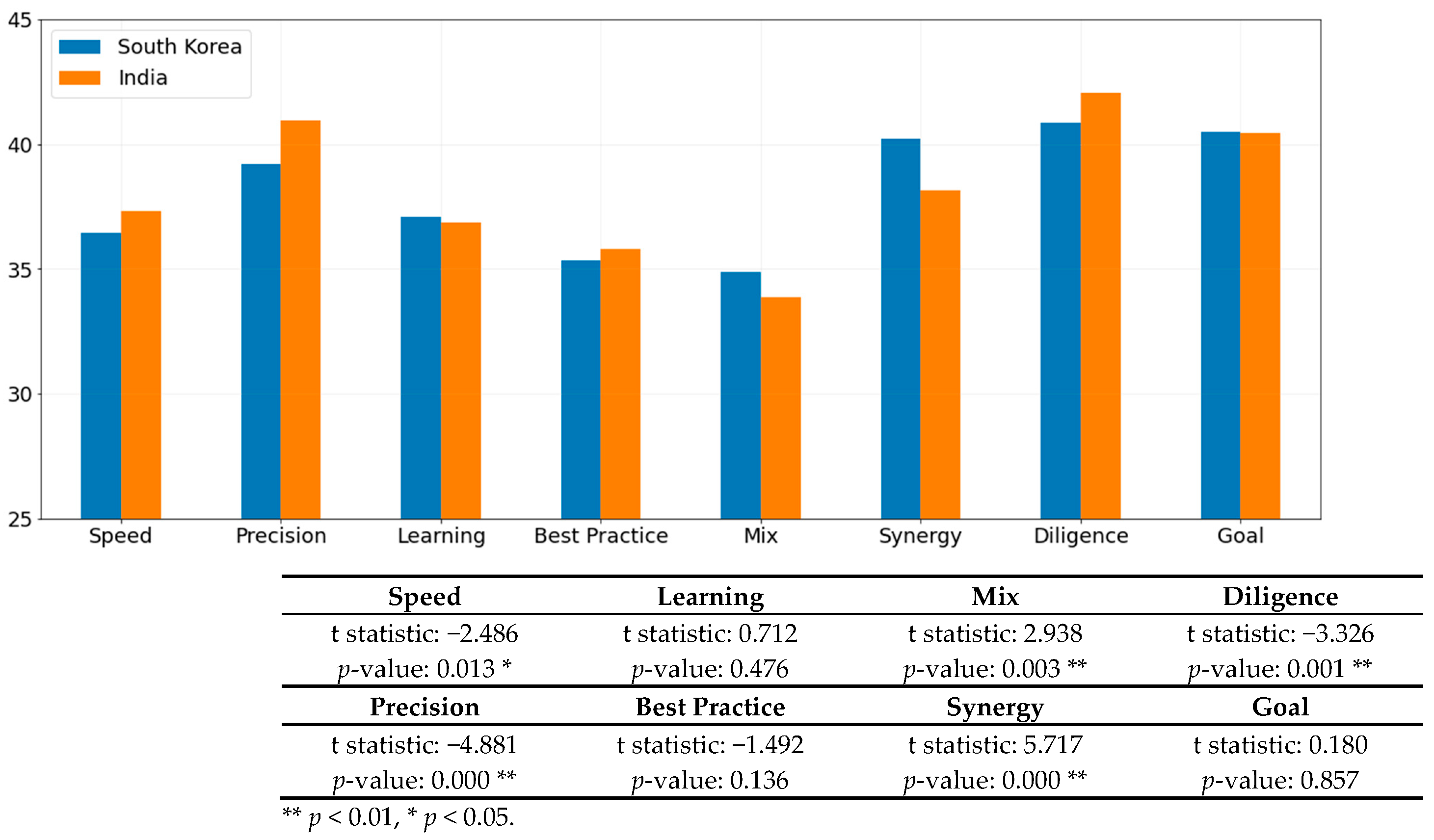The Competitive Advantage of the Indian and Korean Film Industries: An Empirical Analysis Using Natural Language Processing Methods
Abstract
1. Introduction
2. Literature Review
3. Conceptual Framework and Hypotheses
3.1. Conceptual Framework: The ABCD Model
3.2. Hypotheses
- Question 1.
- Between South Korea and India, which country produces better films?
- Question 2.
- Why are Indians not capable of making world-class movies like Koreans?
- Question 3.
- Why are Korean movies more famous than Indian movies?
- Question 4.
- Why is Indian Bollywood culture not as globally popular as K-Pop/Korean dramas?
4. Materials and Methods
4.1. Creating a Keyword List
4.2. Data Collection
4.3. Text Pre-Processing
4.4. Text Vectorization and Similarity Measurement
5. Results
6. Discussion
7. Conclusions
Author Contributions
Funding
Institutional Review Board Statement
Informed Consent Statement
Data Availability Statement
Conflicts of Interest
References
- Porter, M.E. Competitive Advantage of Nations; Free Press: New York, NY, USA, 1990. [Google Scholar]
- Ruiz-Ortega, M.J.; Parra-Requena, G.; Garcia-Villaverde, P.M. Do territorial agglomerations still provide competitive advantages? A study of social capital, innovation, and knowledge. Int. Reg. Sci. Rev. 2016, 39, 259–290. [Google Scholar] [CrossRef]
- Porter, M.E. Competitive Strategy; Free Press: New York, NY, USA, 1980. [Google Scholar]
- Moon, H.-C. The Strategy for Korea’s Economic Success; Oxford University Press: New York, NY, UK, 2016. [Google Scholar]
- Paksiutov, G.D. Transformation of the Global Film Industry: Prospects for Asian Countries. Transformation 2021. [Google Scholar] [CrossRef]
- Dastidar, S.G.; Elliott, C. The Indian film industry in a changing international market. J. Cult. Econ. 2020, 44, 97–116. [Google Scholar] [CrossRef]
- UNESCO Institute for Statistics (UIS Statistics). Available online: http://data.uis.unesco.org (accessed on 22 January 2022).
- Curtin, M. Playing to the World’s Biggest Audience; University of California Press: Oakland, CA, USA, 2007. [Google Scholar]
- The Korea Times. ’Squid Game’ Becomes Netflix’s Top-Ranking Show for Longest 47 Days. Available online: https://www.koreatimes.co.kr/www/art/2021/11/688_318619.html (accessed on 11 November 2021).
- Arirang, S. Korea Is Content Battleground for Global Streaming War since ’Squid Game’ Release: WSJ. Available online: http://www.arirang.com/news/News_View.asp?nseq=290426&sys_lang=Eng (accessed on 29 December 2021).
- Barat, S. The marketization of bollywood. In World Entertainment Media; Routledge: Oxfordshire, UK, 2019; pp. 182–192. [Google Scholar]
- Moon, H.-C. The strategy for Korea’s economic success: Innovative growth and lessons from Silicon Valley. Rev. Int. Area Stud. 2017, 26, 1–33. [Google Scholar]
- Moon, H.-C.; Yin, W. Four Fundamental Factors for Increasing the Host Country Attractiveness of Foreign Direct Investment: An Empirical Study of India. In Handbook of Advanced Performability Engineering; Springer Nature: Cham, Switzerland, 2021; pp. 299–317. [Google Scholar]
- Moon, H.C.; Yin, W. How Chinese Filmmakers Effectively Respond to Chinese Government Policy for Enhancing Their Competitiveness. Glob. Policy 2020, 11, 47–55. [Google Scholar] [CrossRef]
- Moon, H.-C.; Lee, Y.W.; Yin, W. A new approach to analysing the growth strategy of business groups in developing countries: The case study of India’s Tata Group. Int. J. Glob. Bus. Compet. 2015, 10, 1–15. [Google Scholar]
- Yin, W.; Moon, H.-C.; Lee, Y.W. The success factors of Korean global start-ups in the digital sectors through internationalization. Int. J. Glob. Bus. Compet. 2019, 14, 42–53. [Google Scholar] [CrossRef]
- Antons, D.; Grünwald, E.; Cichy, P.; Salge, T.O. The application of text mining methods in innovation research: Current state, evolution patterns, and development priorities. R&D Manag. 2020, 50, 329–351. [Google Scholar]
- Fetscherin, M. The main determinants of Bollywood movie box office sales. J. Glob. Mark. 2010, 23, 461–476. [Google Scholar] [CrossRef]
- Masih, S.; Ihsan, I. Using academy awards to predict success of bollywood movies using machine learning algorithms. Int. J. Adv. Comput. Sci. Appl. 2019, 10, 438–446. [Google Scholar] [CrossRef][Green Version]
- Gaikar, D.D.; Marakarkandy, B.; Dasgupta, C. Using Twitter data to predict the performance of Bollywood movies. Ind. Manag. Data Syst. 2015, 115, 1604–1621. [Google Scholar] [CrossRef]
- Nanda, M.; Pattnaik, C.; Lu, Q.S. Innovation in social media strategy for movie success: A study of the Bollywood movie industry. Manag. Decis. 2018, 56, 233–251. [Google Scholar] [CrossRef]
- Hong, Y. The power of Bollywood: A study on opportunities, challenges, and audiences’ perceptions of Indian cinema in China. Glob. Media China 2021, 6, 345–363. [Google Scholar] [CrossRef]
- Jin, Y.D. Critical Interpretation of Hybridisation in Korean Cinema: Does the Local Film Industry Create “The Third Space”? Javn. Public 2010, 17, 55–71. [Google Scholar]
- Yecies, B.; Shim, A.-G.; Goldsmith, B. Digital intermediary: Korean transnational cinema. Media Int. Aust. 2011, 141, 137–145. [Google Scholar] [CrossRef]
- Parc, J. The effects of protection in cultural industries: The case of the Korean film policies. Int. J. Cult. Policy 2017, 23, 618–633. [Google Scholar] [CrossRef]
- Parc, J.; Messerlin, P. In search of an effective trade policy for the film industry: Lessons from Korea. J. World Trade 2018, 52, 745–764. [Google Scholar]
- Lorenzen, M.; Täube, F.A. Breakout from Bollywood? The roles of social networks and regulation in the evolution of Indian film industry. J. Int. Manag. 2008, 14, 286–299. [Google Scholar] [CrossRef]
- Moon, H.-C. The Art of Strategy: Sun Tzu, Michael Porter, and Beyond; Cambridge University Press: Cambridge, UK, 2018. [Google Scholar]
- Narayanan, V.; Fahey, L. The relevance of the institutional underpinnings of Porter’s five forces framework to emerging economies: An epistemological analysis. J. Manag. Stud. 2005, 42, 207–223. [Google Scholar] [CrossRef]
- Peng, M.W.; Sun, S.L.; Pinkham, B.; Chen, H. The institution-based view as a third leg for a strategy tripod. Acad. Manag. Perspect. 2009, 23, 63–81. [Google Scholar] [CrossRef]
- Barney, J. Firm resources and sustained competitive advantage. J. Manag. 1991, 17, 99–120. [Google Scholar] [CrossRef]
- Winter, S.G. Understanding dynamic capabilities. Strateg. Manag. J. 2003, 24, 991–995. [Google Scholar] [CrossRef]
- Liu, J.; Baskaran, A.; Li, S. Building technological-innovation-based strategic capabilities at firm level in China: A dynamic resource-based-view case study. Ind. Innov. 2009, 16, 411–434. [Google Scholar] [CrossRef]
- Pisano, G.P. You need an innovation strategy. Harv. Bus. Rev. 2015, 93, 44–54. [Google Scholar]
- Schoemaker, P.J.; Heaton, S.; Teece, D. Innovation, dynamic capabilities, and leadership. Calif. Manag. Rev. 2018, 61, 15–42. [Google Scholar] [CrossRef]
- Teece, D.J.; Pisano, G.; Shuen, A. Dynamic capabilities and strategic management. Strateg. Manag. J. 1997, 18, 509–533. [Google Scholar] [CrossRef]
- Kwak, J.; Zhang, L. Does China love Hollywood? An empirical study on the determinants of the box-office performance of the foreign films in China. Int. Area Stud. Rev. 2011, 14, 115–140. [Google Scholar]
- Kang, H. GitHub Repository. 2022. Available online: https://github.com/llbtl/paper_ssm02 (accessed on 17 March 2022).
- Google News. Available online: news.google.com (accessed on 15 January 2022).
- Camacho-Collados, J.; Pilehvar, M.T. On the role of text preprocessing in neural network architectures: An evaluation study on text categorization and sentiment analysis. arXiv 2017, arXiv:1707.01780. [Google Scholar]
- Loper, E.; Bird, S. Nltk: The natural language toolkit. arXiv 2002, arXiv:cs/0205028. [Google Scholar]
- Wang, W.; Wei, F.; Dong, L.; Bao, H.; Yang, N.; Zhou, M. Minilm: Deep self-attention distillation for task-agnostic compression of pre-trained transformers. Adv. Neural Inf. Process. Syst. 2020, 33, 5776–5788. [Google Scholar]
- Devlin, J.; Chang, M.-W.; Lee, K.; Toutanova, K. Bert: Pre-training of deep bidirectional transformers for language understanding. arXiv 2018, arXiv:1810.04805. [Google Scholar]
- Turian, J.; Ratinov, L.; Bengio, Y. Word representations: A simple and general method for semi-supervised learning. In Proceedings of the 48th Annual Meeting of the Association for Computational Linguistics, Uppsala, Sweden, 11–16 July 2010; pp. 384–394. [Google Scholar]
- SBERT.net Models. Available online: https://www.sbert.net/_static/html/models_en_sentence_embeddings.html (accessed on 15 March 2022).
- Reimers, N.; Gurevych, I. Sentence-bert: Sentence embeddings using siamese bert-networks. arXiv 2019, arXiv:1908.10084. [Google Scholar]
- Tata, S.; Patel, J.M. Estimating the selectivity of tf-idf based cosine similarity predicates. ACM Sigmod Rec. 2007, 36, 7–12. [Google Scholar] [CrossRef]
- Pedregosa, F.; Varoquaux, G.; Gramfort, A.; Michel, V.; Thirion, B.; Grisel, O.; Blondel, M.; Prettenhofer, P.; Weiss, R.; Dubourg, V. Scikit-learn: Machine learning in Python. J. Mach. Learn. Res. 2011, 12, 2825–2830. [Google Scholar]
- Parc, J. Business integration and its impact on film industry: The case of Korean film policies from the 1960s until the present. Bus. Hist. 2021, 63, 850–867. [Google Scholar] [CrossRef]
- Hoskins, C.; Mirus, R. Reasons for the US dominance of the international trade in television programmes. Media Cult. Soc. 1988, 10, 499–515. [Google Scholar] [CrossRef]
- Yin, W. A new model for globalization in the film industry: Lessons from Sino-US film co-productions. Krit. Kult. 2019, 32, 117–140. [Google Scholar] [CrossRef]
- BBC News. A New Direction for Indian Cinema? Available online: https://www.bbc.com/culture/article/20130523-indian-cinema-getting-real (accessed on 2 February 2022).
- Bakker, G. The decline and fall of the European film industry: Sunk costs, market size, and market structure, 1890–1927. Econ. Hist. Rev. 2005, 58, 310–351. [Google Scholar] [CrossRef]
- Lorenzen, M. Internationalization vs. globalization of the film industry. Ind. Innov. 2007, 14, 349–357. [Google Scholar] [CrossRef]




| Agility | Benchmarking | ||
|---|---|---|---|
| Speed | Precision | Learning | Best Practice |
| speed | precise | learning | guide |
| speedy | preciseness | evaluating | guideline |
| fast | accurateness | experimenting | ideal |
| fastness | accurate | comparing | indicator |
| swift | accuracy | imitating | index |
| swiftness | clarity | copying | exemplar |
| rapidity | clearness | measuring | model |
| rapidly | correctness | testing | norm |
| prompt | careful | trying | paradigm |
| promptitude | dependability | discovering | pattern |
| hurry | detail | tracing | reference |
| haste | detailed | developing | prototype |
| quick | distinctness | advancing | specification |
| quickness | exactitude | strengthening | standard |
| legerity | exactness | checking | archetype |
| responsiveness | exhaustive | researching | mark |
| suppleness | on target | optimizing | yardstick |
| reflex | well aimed | identifying | criterion |
| resilience | refinement | retrieving | touchstone |
| acceleration | meticulous | analyzing | level |
| deftness | infallible | determining | baseline |
| nimbleness | fineness | verifying | distinction |
| proficient | closeness | understanding | value |
| adaptability | veracity | enhancing | condition |
| velocity | perfection | estimating | character |
| celerity | strictness | surveying | target |
| flexibility | constancy | emulating | basis |
| lightness | quality | finding | blueprint |
| Convergence | Dedication | ||
| Mix | Synergy | Diligence | Goal |
| combination | synergic | attentiveness | motivated |
| union | coefficient | carefulness | self-discipline |
| uniformity | mutual gain | putting efforts | driving force |
| confluence | interchange | continuance | strong desire |
| mixture | team effort | constancy | aimful |
| merging | connected effort | commitment | determined |
| blending | combined effect | hard work | enthusiastic |
| integrating | powering | perseverance | inspired |
| connecting | reinforcing | devotion | striving |
| coming together | leverage | ability to focus | energetic |
| joining | harmonious | passion | enterprising |
| crossing | joint action | willingness | ambitious |
| interconnection | efficiency | conscientiousness | aspirational |
| combining | usability | persistence | self-driven |
| crossing | practicality | engagement | high-reaching |
| meeting | cooperation | loyalty | zealous |
| linking | coopetition | continuity | resolute |
| interchange | concurrence | fortitude | intent |
| intersection | interplay | tenacious | self-starting |
| associating | pulling together | carrying out | destined |
| consolidation | dynamic | concentration | aggressive |
| hybridity | concurring | exertion | earnest |
| intermixing | interdependent | industrious | resourceful |
| bridging | complementary | endurance | vigorous |
| pairing | cooperative | steady | purposeful |
| broaden | interaction | thoroughness | inspired |
| diversify | coexistence | assiduous | eager |
| transform | united | sedulity | unwavering |
| No | Doc ID | Article | Sentence |
|---|---|---|---|
| 0 | 0 | Indian Cinema is not just Hindi Cinema: As language barrier comes down, Southern movies are ready to dominate | Actor Dhanush has earned the coveted Best Actor award at the renowned BRICS Film Festival for his portrayal in ‘Asuran’. |
| 1 | 0 | Dhanush is an Indian actor, producer, director, writer, lyricist, dancer, and playback singer who works mostly in the Tamil film industry and occasionally in Hindi cinema. | |
| 2 | 0 | ‘Asuran’ is a script-driven, low-budget (in terms of set and technical components) film that sends a social message and has a socially relevant topic. | |
| 3 | 0 | Also read|BRICS Film Festival 2021: Dhanush wins Best Actor for ‘Asuran’ Another such film, ‘Jai Bhim’ was so good that it obtained better ratings than some of biggest Hollywood movies on Internet Movie Database (IMDb) portal. | |
| 4 | 0 | Also read|Indian film ‘Jai Bhim’ beats ‘The Shawshank Redemption’ to become top-rated on IMDb The success of such reality-based and content-driven South Indian films raise the question: Where does Hindi cinema fit into the picture? | |
| … | … | … | … |
| 2328 | 57 | Down with COVID-19, film industry eyes release of two Bollywood films for revival | And as the industry is not recognised by many banks, we do not get the support required and we have to resort to private institutions for debt and the interest there is very high. |
| 2329 | 57 | In addition, the nature of business is risky, so the interest rates are high”, he explained. | |
| 2330 | 57 | This is why many films have taken to direct to digital releases due to which the box office has lost around Rs 580 crore from the release of 26 films that released on over the top (OTT) platforms first. | |
| 2331 | 57 | While there are uncertainties for both the film and theatre business, multiplex operators like PVR and INOX are seeing growth in occupancy levels with every new release. | |
| 2332 | 57 | However, it will be Akshay Kumar’s Bell Bottom that will have to do the heavy lifting in bringing back audiences in large numbers to theatres. |
| No | Doc ID | Article | Sentence |
|---|---|---|---|
| 0 | 0 | Is Squid Game the dawn of a TV revolution? | The South Korean series Squid Game became Netflix’s most-watched show of all time in 2021. |
| 1 | 0 | Its success could spark enormous changes in what we watch in 2022 and beyond, writes Al Horner. | |
| 2 | 0 | When Bong Joon-ho won best picture for Parasite at the 2020 Oscars, his acceptance speech included a message to Western audiences. | |
| 3 | 0 | “Once you overcome the one-inch-tall barrier of subtitles, you will be introduced to so many more amazing films”, he told filmgoers who may historically have avoided non-English language movies or worse yet, waited for their inevitable American remakes. | |
| 4 | 0 | The director did not have to wait long for signs his wish could be coming true. | |
| … | … | … | … |
| 1919 | 57 | South Korea’s Busan Festival Opens With ‘Parasite’ Stars and a Spirit of Recovery | You could say that it s a natural transition, but I think these are the barriers we need to overcome. |
| 1920 | 57 | In an interview with a Korean press, Park Hyeong-joon, the new mayor of Busan, seemed clearly aware of the impact of the government s interference on the festival s reputation, and said, Film festivals should not be swayed politically. | |
| 1921 | 57 | On Wednesday, Park, who attended the opening-night event, said: As an avid fan of BIFF, I watched what was happening to the festival over the years and cheered [for its success]. | |
| 1922 | 57 | Now as mayor, I will spare no effort to support the festival for it to become the center of world cinema. | |
| 1923 | 57 | The Busan International Film Festival runs 6–15 October, closing with Anita, Hong Kong director Longmond Leung s biopic about Cantopop star Anita Mui. |
| Agility (H1) | Benchmarking (H2) | Convergence (H3) | Dedication (H4) | ||||
|---|---|---|---|---|---|---|---|
| Reject | Reject | Accept | Reject | ||||
| Speed (H1a) | Precision (H1b) | Learning (H2a) | Best Practice (H2b) | Mix (H3a) | Synergy (H3b) | Diligence (H4a) | Goal (H4b) |
| Korea < India | Not significant | Korea > India | Korea < India | Not significant | |||
Publisher’s Note: MDPI stays neutral with regard to jurisdictional claims in published maps and institutional affiliations. |
© 2022 by the authors. Licensee MDPI, Basel, Switzerland. This article is an open access article distributed under the terms and conditions of the Creative Commons Attribution (CC BY) license (https://creativecommons.org/licenses/by/4.0/).
Share and Cite
Kang, H.; Yin, W.; Kim, J.; Moon, H.-C. The Competitive Advantage of the Indian and Korean Film Industries: An Empirical Analysis Using Natural Language Processing Methods. Appl. Sci. 2022, 12, 4592. https://doi.org/10.3390/app12094592
Kang H, Yin W, Kim J, Moon H-C. The Competitive Advantage of the Indian and Korean Film Industries: An Empirical Analysis Using Natural Language Processing Methods. Applied Sciences. 2022; 12(9):4592. https://doi.org/10.3390/app12094592
Chicago/Turabian StyleKang, Hyewon, Wenyan Yin, Jinho Kim, and Hwy-Chang Moon. 2022. "The Competitive Advantage of the Indian and Korean Film Industries: An Empirical Analysis Using Natural Language Processing Methods" Applied Sciences 12, no. 9: 4592. https://doi.org/10.3390/app12094592
APA StyleKang, H., Yin, W., Kim, J., & Moon, H.-C. (2022). The Competitive Advantage of the Indian and Korean Film Industries: An Empirical Analysis Using Natural Language Processing Methods. Applied Sciences, 12(9), 4592. https://doi.org/10.3390/app12094592







